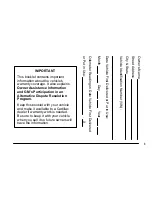
WARNING!
BAS cannot prevent the natural laws of physics from
acting on the vehicle, nor can it increase the traction
afforded by prevailing road conditions. BAS cannot
prevent accidents, including those resulting from
excessive speed in turns, driving on very slippery
surfaces, or hydroplaning. The capabilities of a BAS-
equipped vehicle must never be exploited in a reck-
less or dangerous manner, which could jeopardize
the user’s safety or the safety of others.
Traction Control System (TCS)
This system monitors the amount of wheel spin of each of
the driven wheels. If wheel spin is detected, brake
pressure is applied to the slipping wheel(s) and engine
power is reduced to provide enhanced acceleration and
stability. A feature of the TCS functions similar to a
limited slip differential and controls the wheel spin
across a driven axle. If one wheel on a driven axle is
spinning faster than the other, the system will apply the
brake of the spinning wheel. This will allow more engine
torque to be applied to the wheel that is not spinning.
This feature remains active even if TCS and ESC are in
the “Partial Off” mode. Refer to “Electronic Stability
Control (ESC)” in this section for more information.
Electronic Roll Mitigation (ERM)
This system anticipates the potential for wheel lift by
monitoring the driver’s steering wheel input and the
speed of the vehicle. When ERM determines that the rate
of change of the steering wheel angle and vehicle’s speed
are sufficient to potentially cause wheel lift, it then
applies the appropriate brake and may also reduce
engine power to lessen the chance that wheel lift will
occur. ERM will only intervene during very severe or
evasive driving maneuvers. ERM can only reduce the
chance of wheel lift occurring during severe or evasive
5
STARTING AND OPERATING
359
Summary of Contents for Journey 2011
Page 1: ...Journey O W N E R S M A N U A L 2 0 1 1 ...
Page 4: ......
Page 7: ...INTRODUCTION 5 ...
Page 10: ......
Page 128: ...Voice Tree 126 UNDERSTANDING THE FEATURES OF YOUR VEHICLE ...
Page 158: ...Voice Tree 156 UNDERSTANDING THE FEATURES OF YOUR VEHICLE ...
Page 159: ...3 UNDERSTANDING THE FEATURES OF YOUR VEHICLE 157 ...
Page 164: ...Voice Tree 162 UNDERSTANDING THE FEATURES OF YOUR VEHICLE ...
Page 165: ...3 UNDERSTANDING THE FEATURES OF YOUR VEHICLE 163 ...
Page 166: ...164 UNDERSTANDING THE FEATURES OF YOUR VEHICLE ...
Page 167: ...3 UNDERSTANDING THE FEATURES OF YOUR VEHICLE 165 ...
Page 260: ...INSTRUMENT CLUSTER 258 UNDERSTANDING YOUR INSTRUMENT PANEL ...
Page 332: ......
Page 374: ...372 STARTING AND OPERATING ...
Page 426: ......
Page 452: ......
Page 524: ......
Page 535: ...INDEX 10 ...
















































